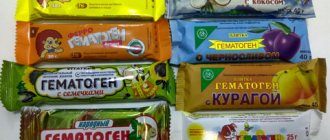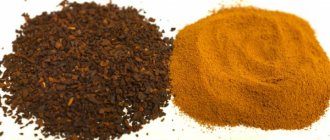Corvalol
- a combination drug consisting of several active ingredients. The composition of Corvalol is as follows (starting with the strongest component and ending with the weakest):
- Ethyl alcohol 95%
. According to many doctors, this is almost the main active ingredient of Corvalol. Ethyl alcohol (aka alcohol) has a sedative (calming, inhibitory) effect on the nervous system, and through it on the entire body. Its second effect is an analgesic, and this effect applies to all types of pain. In large doses it can cause a state of anesthesia with complete loss of consciousness and pain sensitivity. It is a psychoactive substance that can change and darken consciousness and cause mental and physical dependence. - Phenobarbital
. Sleeping substance. Just like alcohol, it has an inhibitory effect on the central nervous system, causing a decrease in pain sensitivity. The second most powerful active ingredient (after ethyl alcohol) is Corvalol. Just like ethyl alcohol, it is a psychoactive substance and can cause addiction. When combined with alcohol, phenobarbital produces a strong sedative effect that affects all psychosomatic symptoms. - Peppermint leaf oil
. The main component is menthol, which provides a slight analgesic and calming effect. - Ethyl bromoisovalerianate
(ethyl ester of alpha-bromoisovaleric acid). It is the active ingredient of the essential oil of a plant such as Valerian officinalis (or “Cat grass”). This perennial herb has been known for its calming effects since antiquity.
Available in bottles of 15 and 25 milliliters. The recommended dose of Corvalol is 15-30 drops orally at a time, up to 2 or 3 times a day.
Medicines similar to Corvalol are common in our country: valocordin, valoserdin, corvaldin.
The effect of Corvalol and what it helps with
The main effect of the drug is a sedative effect. Additional actions include dilating small blood vessels, relieving spasms, and reducing muscle tone. The benefit (therapeutic effect) of Corvalol is its rapid sedative and analgesic effect. This is useful for reactions to stress and mental trauma, neurotic conditions, and all types of psychosomatic diseases: hypertension, palpitations, asthma attacks, a feeling of a lump in the throat, irritable bowel syndrome, itchy skin and rashes.
Corvalol is not classified as a potent drug (despite the fact that it contains them) and therefore can be easily purchased at a pharmacy without a doctor's prescription. According to the DSM Group and the RBC portal, Corvalol is one of the best-selling drugs in the country in terms of the number of packages, second only to some painkillers.
According to surveys of doctors, it is extremely rarely recommended for use for therapeutic purposes, and only as a one-time (one-time) dose. From which we can conclude that the majority of purchased Corvalol is not used as prescribed by a doctor.
What is the reason for such a widespread use of Corvalol (and its analogues - valocordin, valoserdin)?
In our opinion, there are three main reasons
- Long-term history of admission. The drug has been known since “Soviet times”. Due to the fact that phenobarbital in combination with alcohol has a strong inhibitory effect on the nervous system, after taking Corvalol, the severity of symptoms of psychosomatic origin decreases. This is where the illusion arises that the drug helps with almost all diseases: from hypertension to alcohol hangover, from heart pain to seizures. That is, due to the specificity of its action, Corvalol can cause relief (albeit temporary) in many painful conditions.
- Lack of accessible, reliable other sedatives. Psychiatric illiteracy of the population. Low appeal to psychotherapists and psychiatrists. Often, with many mental disorders caused by overexcitation of the nervous system (reaction to stress, neuroses, psychosomatic diseases, insomnia, etc.), people do not turn to a specialist psychotherapist, but tend to seek relief by taking some kind of universal sedative.
- A large number of people dependent on Corvalol. Also, people with alcohol addiction often use alcohol-containing medications as a substitute for alcoholic beverages, using Corvalol, Valocordin, tinctures of hawthorn, valerian, motherwort, etc. Dependence on Corvalol has all the signs of drug addiction: mental, then physical dependence on Corvalol is formed. According to the observations of psychiatrists and psychiatrists - narcologists, there are a lot of Corvalol addicts among adults and elderly people.
Corvalol
Corvalol belongs to the group of sedatives. It contains phenobarbital, which is a psychotropic drug, isovaleric acid ester and peppermint leaf oil. Due to the last component, not only the specific smell of Corvalol is provided, but also a reflex antispasmodic and vasodilating effect. A derivative obtained from valerian roots has a calming effect on the nervous system, and in large doses causes drowsiness. Thus, the effect of Corvalol is due to its composition, which, in addition to the listed components, includes ethyl alcohol, sodium hydroxide and water.
Previously, there was only liquid Corvalol, drops of which had to be diluted with a certain volume of water. Currently, for the convenience of patients, Corvalol is produced in tablets for sublingual use.
Corvalol tablets are easy to use
It is interesting that this drug is distributed mainly in the Balkan Peninsula and in Russia. In other countries, they use a medicine that has a similar composition (valocordin). Phenobarbital, which is part of both drugs, is considered a drug in some countries (USA, Lithuania) and is prohibited for import.
Indications for use
The use of Corvalol is indicated for the following conditions:
- changes in the function of the cardiovascular system associated with impaired neurohumoral regulation;
- in complex therapy of neuroses, as well as with increased excitability and irritability;
- for taking the drug Corvalol, indications include difficulty falling asleep due to increased anxiety;
- tachycardia. associated with the influence of the sympathetic nervous system;
- early stages of hypertension and minor spasm of the coronary arteries;
- increased tone of the autonomic nervous system, accompanied by excitement;
- spasms and increased peristalsis of the gastrointestinal tract.
How many drops of Corvalol to take in a given case is determined by the doctor, but the average dosage is 20-40 drops three times a day.
Contraindications
Contraindications for taking Corvalol are individual allergic reactions and intolerance to the components of the drug, as well as severe somatic diseases accompanied by severe renal or liver failure.
The calming effect of Corvalol has a beneficial effect on the cardiovascular system
Overdose
If an acute overdose of Corvalol occurs, intestinal motility slows down, and this leads to constipation.
With long-term use of the drug, chronic bromine poisoning is possible, which is manifested by depression and apathy, as well as damage to the mucous membranes (rhinitis, conjunctivitis), blood vessels (hemorrhagic diathesis) and the central nervous system (impaired speech, memory, attention, unsteadiness of gait). Libido often decreases and impotence develops.
Side effects
Side effects usually do not occur with the correct dosage of the drug. However, dizziness and daytime drowsiness may sometimes occur. In some cases, drug dependence develops, and when it is discontinued, abstinence occurs.
Corvalol and alcohol
This drug is often used to eliminate symptoms that occur after drinking large amounts of alcohol (hangover). These include increased heart rate. increased blood pressure, increased excitability. Due to the fact that Corvalol and alcohol have a sedative effect, when used together, an overdose and various side effects may develop.
Corvalol during pregnancy
Corvalol can be used during pregnancy, as well as during breastfeeding, only under strict indications. That is, if the expected benefit exceeds the harm that is likely to be caused to the child. This is due to the fact that phenobarbital, which is part of this medicine, can negatively affect the condition and development of the baby’s central nervous system, and also lead to intrauterine hypoxia.
Corvalol for children
Corvalol can be prescribed to children in special situations, and the dose should be reduced depending on age (one drop per one year of life). Interestingly, some doctors prescribe its use almost from birth, while others do not recommend taking it before 12 years of age. Since there is no consensus on this matter, it is worth listening to the opinion of your doctor, since only he has sufficient information about the child.
Corvalol is an indispensable drug in some situations when it is necessary to eliminate the symptoms of severe shock or dysfunction of the nervous system. It is also suitable as a temporary measure for tachycardia and hypertension. However, with long-term use, Corvalol often causes addiction and the development of side effects. Therefore, you should not self-medicate, but rather seek help from a specialist.
hemorrhagic vasculitis in children (video for doctors)
Harm of Corvalol.
With a single dose, the harm of Corvalol can only consist of possible allergic reactions, increased inhibitory effects of other medications taken, and overdose when taken in large doses. The main danger lies in cases of long-term and constant use of Corvalol. In such cases, the nervous system suffers: toxic encephalopathy develops with sleep disturbances, memory loss (even dementia), polyneuropathy; when Corvalol is withdrawn, convulsions and a withdrawal state with psychosis may develop. Long-term use of Corvalol is harmful with a high risk of developing mental and physical dependence, because, as written above, it contains two strong psychoactive substances: ethyl alcohol and phenobarbital. Treatment of encephalopathy and addiction caused by Corvalol may require hospitalization.
In conclusion, I would like to point out that medications should be taken only as prescribed by a doctor. Self-medication is dangerous!
Corvalol contains two strong psychotropic components: ethyl alcohol and phenobarbital. With constant use, it causes dependence and the need to take larger and larger doses, and after stopping its use or reducing the dose, withdrawal syndrome develops. Be careful with Corvalol and you will be healthier!
Corvalol drops vn approx 25 ml fl-cap t/st/pack cards x1
Trade name: Corvalol International name: Peppermint leaves oil + Phenobarbital + Ethylbromisovalerinate (Menthae piperitae oleum + Phenobarbital + Ethylbromisovalerinate)
Release form: drops for oral administration (dark glass dropper bottles, dark glass bottles) 15, 25 ml
Ingredients: peppermint leaves oil 1.42 g, phenobarbital 18.26 g, ethyl bromizovalerate 20 g - 1 l
Pharmacological group: sedative
Pharmacological group according to ATK: N05CM (Other hypnotics and sedatives)
Pharmacological action: sedative, antispasmodic,
Indications: As a sedative and vasodilator for the following diseases: functional disorders of the cardiovascular system (cardialgia, sinus tachycardia, increased blood pressure), insomnia (impaired sleep), neurotic conditions, autonomic lability, irritability, hypochondriacal syndrome. As an antispasmodic drug - spasm of the muscles of the gastrointestinal tract (intestinal and biliary colic).
Dosage regimen: Orally, before meals, 15-30 drops, pre-dissolved in a small amount (30-50 ml) of water, 2-3 times a day. A single dose, if necessary (for example, for tachycardia) can be increased to 40-50 drops. Children - 3-15 drops/day (depending on age and clinical picture of the disease). The duration of use of the drug is determined by the doctor individually.
Contraindications: Hypersensitivity, severe hepatic and/or renal failure, lactation period (if it is necessary to prescribe during feeding, the issue of stopping feeding should be decided).
Side effects: Drowsiness, dizziness, decreased ability to concentrate, allergic reactions. With long-term use - chronic bromine poisoning (depression, apathy, rhinitis, conjunctivitis, hemorrhagic diathesis, impaired coordination of movements), drug dependence.
Pharmacodynamics: A combined drug whose effect is determined by the properties of its constituent substances. Has a sedative and antispasmodic effect. Facilitates the onset of natural sleep. Alpha-bromoisovaleric acid ethyl ester has a sedative (similar to the effect of valerian) and antispasmodic effects. Phenobarbital enhances the sedative effect of other components, helps reduce central nervous system excitation and facilitates the onset of sleep. Peppermint oil has a reflex vasodilating and antispasmodic effect.
Special instructions: During the treatment period, care must be taken when driving vehicles and engaging in other potentially hazardous activities that require increased concentration and speed of psychomotor reactions. Carefully. Pregnancy.
Dispensed from pharmacies: Dispensed without a prescription.
Drug registration number: P No. 014513/01-2002
Date of registration (re-registration) of the drug: 11.11.2002











